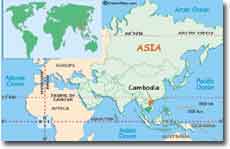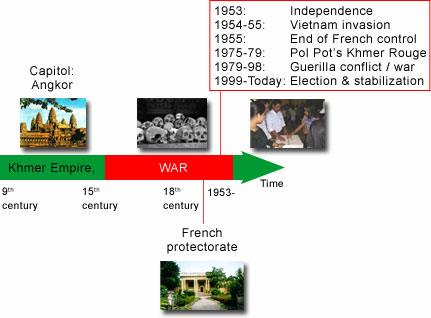
Where is the Kingdom of Cambodia?

Cambodia area:
total: 181,040 sq km (slightly smaller than Oklahoma)
land: 176,520 sq km
water: 4,520 sq km
Land use:
arable land: 20.44% permanent crops: 0.59% other: 78.97% (2005)
Population: 13,881,427
Median Age: 20.6
Growth: 1.78%
Short history of Cambodia

Government of Cambodia
Under the constitution promulgated in 1993 and subsequently
amended, Cambodia is a constitutional monarchy headed by a king; the
king is chosen by the Royal Council of the Throne from the members
of the royal family.
The bicameral parliament consists of a popularly
elected National Assembly with at least 120 members and a Senate with
no more than half the number of members of the National Assembly.
Members of parliament serve five-year terms.
The government is headed by a premier, who must have
the support of two thirds of the members of the National Assembly.
Current issues in Cambodia
Apathy and unawareness
There is no clear public or official desire for biodiversity conservation
or protected area management, in spite of government statements to
the contrary. There is no apparent public recognition that biodiversity
or protected areas contribute towards filling any meaningful human
needs. Rural people are not familiar with the concept of protected
areas. Absence of demarcation on the ground exacerbates the problem.
There is little or no public support; nor is there adequate public
information about protected areas and the laws that apply to them,
which might help to dispel current apathy and ignorance.
Lack of security
Continuation of civil war activity is a bar to any form of land use
management in affected areas. Land mines endanger human and wild animals
especially in northern areas.
Logging
Logging occurs in all protected areas, sometimes on an intensive scale.
Fifteen protected areas have commercially valuable timber species,
making them especially vulnerable. RCAF units entrusted with protecting
forest resources ignore or encourage logging. Land adjacent to protected
areas is often allocated for authorised timber extraction, providing
opportunities for logging companies to disguise unauthorised harvesting
in protected areas.
Legal ambiguity
Statutory laws for protected areas, by Decree or through the Law on
the Environment, are said to be unenforceable because the sub-decrees
required to set specific regulations in place have not yet been promulgated.
This seems questionable to the extent that MoE has at least some legal
claim to protected areas declared by Royal Decree, compared with trespassers
who have no legal rights of any sort. It appears, however, that MoE
makes little or no attempt to test the claims of those who exploit
resources in protected areas. That it fails to do so suggests a lack
of political will and a confused belief that once sub-decrees are
promulgated all with be well. In mitigation it is argued that if attempts
were made to test a claim, courts could not be relied upon to give
impartial judgements.
Corruption Massive corruption characterises
the timber industry and effectively neutralises what little law does
exist. ‘The co-Prime Ministers authorise virtually every concession,
illegal timber export and permits to confiscate old felled logs’ (Anon.
1998c). The same source also implicates the Prime Ministers of Thailand
and Viet Nam and the RCAF and observes that. DFW officials fail to
confront the issue of illegal logging, perhaps because of intimidation.
Abuse of wetlands
Wetland habitat is being lost through conversion of swamp to agriculture.
Forest removal around Tonlé Sap has led to increased siltation decreased
depth. The life cycles of fishes that move between main river systems
and spawning areas in upstream tributaries or swamp forests are being
disrupted.
Inadequate resources
Most protected areas are unmanned. Those that are manned are ill equipped
and without transport other than shared bicycles. Most protected areas
are remote, access is difficult and security is poor. Malaria is a
constant threat. Most areas lack a permanent ministerial presence
so that capacity for enforcing those laws that do exist is low. Lawlessness,
intimidation and corruption are rife.
Inadequate mechanisms for coordination
Co-ordination between agencies responsible for different aspects of
land use appears to be absent or inadequate.
Local pressures
Most (perhaps all) protected areas have human settlements and associated
shifting cultivation within. People living in or nearby protected
areas harvest NTFP (including wild animals) from within. They also
cause fires that thin out the fire tolerant dry dipterocarp forests
year by year. Not all people originated locally. Some are outsiders
who have come there to find land and access to forest resources. When
conflicts arise over land use local politicians side with people who
are cultivating or using protected areas in other ways.
Illegal hunting is widespread wherever sufficient
animals remain to make this a worthwhile activity. According to an
article in the Cambodia Daily of 18 Feb 1999, poachers have taken
to using homemade explosives to trap and kill tigers, chiefly to harvest
their bones and skins. The economic value of a single tiger’s by-products
is estimated to be at least $1,500 to the middlemen who smuggle them
across international borders, which is more than four times average
annual income.
Size of the protected area system
The protected areas have been selected with biodiversity conservation
and representativeness firmly in mind resulting in an admirably designed
system that covers over18 per cent of total land area (16 per cent
of IUCN management categories I to IV). However, it is doubtful whether
any other country in the world can match this and it must seriously
be questioned whether such an enormous system can be put under effective
control in the foreseeable future, while rising rural populations
continue to exert increasing demands upon unoccupied land, exacerbated
by lawlessness and apparent lack of any significant public concern.
Dwindling donor support
Donor support accounts for 90 per cent of all protected area funding.
Continuance beyond 1998 is in jeopardy.
Uncontrolled wildlife trade
The cross border trade described above adds to Cambodia's natural
resource impoverishment.
Environmental activities
in Cambodia
The Department of Nature Conservation and Protection under
the Ministry of Environment has the responsibility for overseeing
these 23 protected areas and 3 Ramsar sites, two of which are contained
within the 23 protected areas. Combined, all of these areas cover
32,289 km².
Unrelated to the Law on the Environment, provisions for protected
areas were declared by Royal Decree 'Creation and designation of protected
areas', 1 November 1993. Levels of protection are defined by Ministerial
decree (Prakas Ref. 1033). However, these only state the principles
for protected areas: a further Sub-Decree is required to establish
their provisions in law, and this has yet to be drawn up. Furthermore,
the laws cannot be enforced until protected area boundaries are demarcated
on the ground. This would be a considerable undertaking. The combined
perimeters of the four national parks presently under some form of
management (Bokor, Kirirom, Verachay and Ream) is at least 600 km,
much of it traversing rugged inaccessible terrain. Completion of boundary
demarcation for even those four areas may be several years in the
future.











